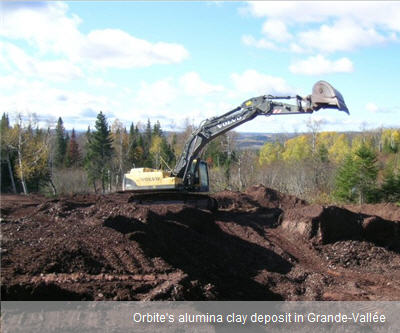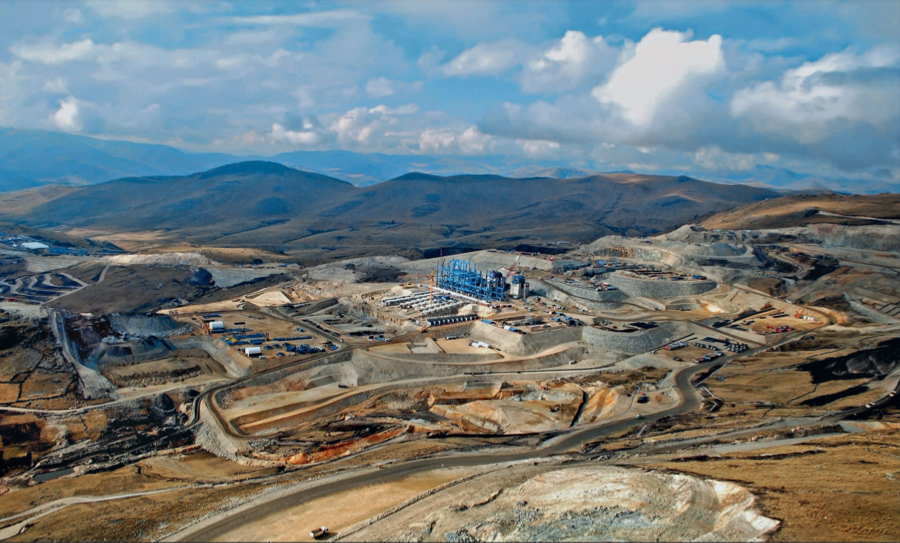Orbite identifies rare earth elements in its Grande-Valee deposit, further enhancing its offering to the aluminum and high-technology industries

Exploration Orbite (TSX VENTURE:ORT.A) is pleased to announce the presence of high-value by-products such as scandium, gallium and other important rare earth elements in its Grande-Vallée deposit, all of which offer strong economic potential for the company and for Canada. The Company is also pleased to announce its filing of a provisional U.S. patent application that extends protection for its existing patented technology to the extraction of scandium, gallium and other rare earth elements from aluminous clay.
Strategic materials in Grande-Vallée
Recent findings showing the presence of elements such as scandium, gallium and other rare earth elements in Orbite’s Grande-Vallée aluminous clay deposit emerged from a geochemical survey on the property performed by the Institut National de Recherche et de Sécurité (INRS) and, more specifically, analyses by Chemex and SGS of 10 characteristic samples extracted from the pilot plant bulk sample originating from the property’s Marin sector. These elements have a high degree of affinity to alumina, the main constituent of interest to Orbite in the Grande-Vallée deposit.
The above analysis, performed by geologist Jean-Guy Levaque B.A., B.Sc.A., P.Eng, and a qualified person within the meaning of National Instrument 43-101 – Standards of Disclosure for Mineral Projects, confirmed an average grade of 18-19 g/ton of scandium in the bulk sample as well as the existence of a high degree of correlation between the scandium element with the aluminum in the deposit exceeding 78%. The assay results also confirmed the presence of 32-44 g/tonne of gallium in the same bulk sample. In addition to these two elements, other rare earth elements were also detected such as (but not limited to) yttrium 43-53 g/tonne, dysprosium at around 10 g/tonne, neodymium at 65-70 g/tonne, praseodymium at 18-19 g/tonne and lanthanum at about 75-77 g/tonne. Rare earths including scandium totalled 400 to 500 g/tonne.
Sizeable value for the aluminum industry
As a high value add-on, scandium transforms aluminum into a differentiated product that commands a significantly higher price on the market and is of decisive significance to the aerospace industry. “The presence of these rare earth element by-products in our Grande-Vallée deposit, along with the filing of an application for patent protection of an effective method of extracting these elements are extremely exciting strategic developments for our company,” said Richard Boudreault, Orbite President and CEO. “They add tremendous value to our alumina offering and have the potential to add momentous economic value to our expected production numbers. We have initiated discussions with key market players in the industry and look forward to eventually establishing valuable relationships based on this exciting find.”
A new patent application
On March 18, 2011, Orbite filed a new provisional US patent (application U.S. 61/454, 211) for a method for extracting rare earths such as scandium and gallium. It is hoped that this new process and patent will become an additional source of licensing income for the Company based on the growing demand for rare earths from energy and high-technology sectors, which are expected to experience significant growth in the coming years.
The new extraction method adds to Orbite’s existing patent families related to the production of alumina and will enrich the Company’s intellectual property assets. Orbite is constantly innovating to increase its leadership in the industry through the development of its intellectual property claims.
Scandium, Gallium and Dysprosium
Scandium (Sc) is primarily used in aluminum-scandium alloys (between 0.1% and 2.0% of scandium) to make critical aerospace components and high-performance sports equipment. Scandium is also used in various lighting applications such as high-density discharge lamps and metal halide lamps/light bulbs. The prices for aluminum-scandium range from US$74-US$212 per kg. Scandium could thus deliver high strategic added-value to the Canadian Aerospace sector. According to the US Geological Survey (USGS), prices of scandium oxides range from US$900 to US$3260 per kg depending on purity. Mostly a by-product of uranium and platinum mining, world production of scandium is in the order of 2000 kg per year. World consumption presently exceeds 5000 kg per year and is constrained mostly by availability.
Gallium (Ga) is used principally in semiconductors for electronic components such as integrated circuits, ultra-high speed logic chips for cell phones as well as a variety of infrared electro-optical, LED and high efficiency solar-cell production applications. In these last applications, gallium has the potential to further accelerate the growth of the local advanced optoelectronic and solar cell material industry. It is usually extracted from bauxite deposits as a by-product. In 2010, world primary production was estimated at 106 metric tonnes per year. The US Geological Survey pegs the value of 4N (99.99% pure) gallium metal at approximately $US600/kg.
Dysprosium (Dy) and other rare earth elements find growing application in clean tech and energy technologies. The US Department of Energy has listed dysprosium among the most important elements to the clean tech economy (principally used to make magnets for electric and hybrid vehicles and wind turbines), as well as the one most at-risk for supply shortages during the next 15 years. Dysprosium could be enabling to Quebec’s recently released plan for the development of electric car technologies. The world production of dysprosium is presently concentrated in China. Existing production is not sufficient to meet demand, and shortage exists for dysprosium in the manufacture of magnet alloys for example. Its market prices presently exceeds 600$/kg FOB China.
Mr. Levaque is the independent geologist (as per NI 43-101) who carried out the geological work described in the aforementioned analyses and who reviewed and authorized this press release. He also reviewed the findings of the geochemical study carried out by INRS and produced in July 2006, and has recently performed additional testing at both the SGS and Chemex independent laboratories on samples from the Marin sector.
About Orbite
Orbite owns 100% of the mining rights on its 6,441-hectare Grande-Vallée property, the site of an aluminous clay deposit located 32 km northeast of Murdochville, and a 28,000 sq. ft. facility in Cap Chat, both in the Gaspé region. The latest NI 43-101 report issued has identified an Indicated Resource of more than 1BT of aluminous clay in part of the property. The company is considering a first 7000 tpd argillite treatment plant (aimed at the aluminum market) on or near this property. The Company also owns the intellectual property rights to a unique Canada and U.S.-patented process for extracting alumina from aluminous clays for which other international patents are also pending. The Company has cash assets of more than $17 million at present. www.explorationorbite.com
More News
{{ commodity.name }}
{{ post.title }}
{{ post.date }}

Comments